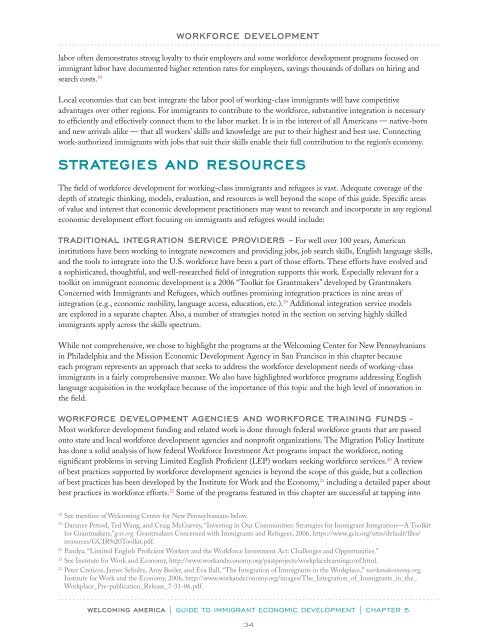IMMIGRANT
npjjbma
npjjbma
- No tags were found...
You also want an ePaper? Increase the reach of your titles
YUMPU automatically turns print PDFs into web optimized ePapers that Google loves.
WORKFORCE DEVELOPMENTlabor often demonstrates strong loyalty to their employers and some workforce development programs focused onimmigrant labor have documented higher retention rates for employers, savings thousands of dollars on hiring andsearch costs. 18Local economies that can best integrate the labor pool of working-class immigrants will have competitiveadvantages over other regions. For immigrants to contribute to the workforce, substantive integration is necessaryto efficiently and effectively connect them to the labor market. It is in the interest of all Americans — native-bornand new arrivals alike — that all workers’ skills and knowledge are put to their highest and best use. Connectingwork-authorized immigrants with jobs that suit their skills enable their full contribution to the region’s economy.Strategies and ResourcesThe field of workforce development for working-class immigrants and refugees is vast. Adequate coverage of thedepth of strategic thinking, models, evaluation, and resources is well beyond the scope of this guide. Specific areasof value and interest that economic development practitioners may want to research and incorporate in any regionaleconomic development effort focusing on immigrants and refugees would include:Traditional Integration Service Providers – For well over 100 years, Americaninstitutions have been working to integrate newcomers and providing jobs, job search skills, English language skills,and the tools to integrate into the U.S. workforce have been a part of those efforts. These efforts have evolved anda sophisticated, thoughtful, and well-researched field of integration supports this work. Especially relevant for atoolkit on immigrant economic development is a 2006 “Toolkit for Grantmakers” developed by GrantmakersConcerned with Immigrants and Refugees, which outlines promising integration practices in nine areas ofintegration (e.g., economic mobility, language access, education, etc.). 19 Additional integration service modelsare explored in a separate chapter. Also, a number of strategies noted in the section on serving highly skilledimmigrants apply across the skills spectrum.While not comprehensive, we chose to highlight the programs at the Welcoming Center for New Pennsylvaniansin Philadelphia and the Mission Economic Development Agency in San Francisco in this chapter becauseeach program represents an approach that seeks to address the workforce development needs of working-classimmigrants in a fairly comprehensive manner. We also have highlighted workforce programs addressing Englishlanguage acquisition in the workplace because of the importance of this topic and the high level of innovation inthe field.Workforce Development Agencies and Workforce Training Funds –Most workforce development funding and related work is done through federal workforce grants that are passedonto state and local workforce development agencies and nonprofit organizations. The Migration Policy Institutehas done a solid analysis of how federal Workforce Investment Act programs impact the workforce, notingsignificant problems in serving Limited English Proficient (LEP) workers seeking workforce services. 20 A reviewof best practices supported by workforce development agencies is beyond the scope of this guide, but a collectionof best practices has been developed by the Institute for Work and the Economy, 21 including a detailed paper aboutbest practices in workforce efforts. 22 Some of the programs featured in this chapter are successful at tapping into18See mention of Welcoming Center for New Pennsylvanians below.19Daranee Petsod, Ted Wang, and Craig McGarvey, “Investing in Our Communities: Strategies for Immigrant Integration—A Toolkitfor Grantmakers,”gcir.org. Grantmakers Concerned with Immigrants and Refugees, 2006, https://www.gcir.org/sites/default/files/resources/GCIR%20Toolkit.pdf.20Pandya, “Limited English Proficient Workers and the Workforce Investment Act: Challenges and Opportunities.”21See Institute for Work and Economy, http://www.workandeconomy.org/pastprojects/workplacelearningconf.html.22Peter Creticos, James Schultz, Amy Beeler, and Eva Ball, “The Integration of Immigrants in the Workplace,” workandeconomy.org.Institute for Work and the Economy, 2006, http://www.workandeconomy.org/images/The_Integration_of_Immigrants_in_the_Workplace_Pre-publication_Release_7-31-06.pdf.WELCOMING AMERICA | GUIDE TO <strong>IMMIGRANT</strong> ECONOMIC DEVELOPMENT | CHAPTER 5.3.4


